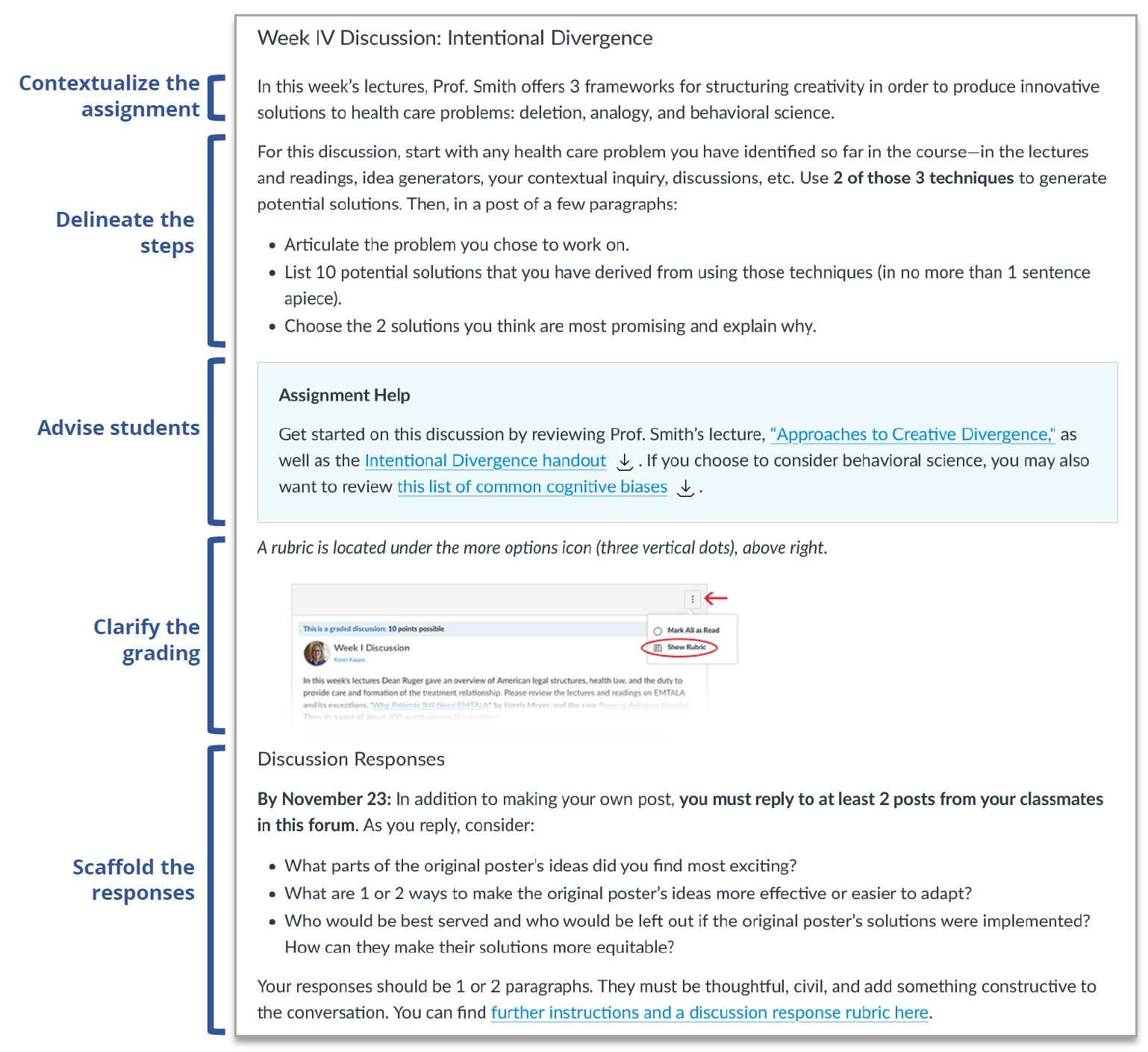Asynchronous discussion forums—and the “post once, reply twice” format—are frequently maligned by faculty and students. Instructors may perceive them as educationally ineffective and incapable of achieving desired learning outcomes, while students may view them as rote or forced. But the problem is not with the discussion forum itself—rather, it is that discussions often seem tacked on, or not intentionally constructed as integral components of a course.
In online, hybrid, or even in-person courses, well-designed asynchronous discussions have the potential to encourage interaction, reinforce course concepts, and motivate students to respond, engage, and return to post again. These assignments can:
-
Build connection
Connection and community are important aspects of class time for students and learning is not as enjoyable or effective without them. -
Foster inclusivity
Asynchronous discussions create an environment that allows all students to participate; it does not privilege quick-thinking extroverts who are not necessarily better in class, just louder and faster. -
Nurture engagement
Engaged students are likely to be more committed to learning, mastering, reflecting on, and applying new material. Asynchronous discussions with peers gives students opportunities to build emotional bridges to course materials. -
Integrate knowledge
Well-designed asynchronous discussions build on connections and engagement to foster cognitive presence: integration, synthesis, and evaluation of ideas that lead both to further inquiry and to situating new knowledge within students’ existing frameworks.
Achieving these goals means designing with 3 key intentions in mind:
-
Alignment with learning objectives and the substance of the course.
-
Engagement with course materials, peers, and the instructional team.
-
Clarity of communication about requirements and grading criteria, as well as the context of the assignment; students should understand what they are supposed to do, and why.
These intentions should be reflected in the structure of the assignment directions, which guides students by providing concrete steps, relevant context, information about grading criteria, and help with completing their work. They should also be reflected in the types of work that students are asked to do; discussions should stimulate engagement and promote higher-level thinking through learner-learner and learner-content interaction.
Structuring Asynchronous Discussions
Effective discussions make it clear to students what activities they will need to complete, why they should be invested, and how they will interact with their peers. Assignment directions:
-
Contextualize the assignment by explaining how the discussion fits into the course.
-
Delineate the steps, being specific and clear about the content, structure, and format of submissions.
-
Advise students by building in help; it is harder for students to ask casual questions in online courses than in person.
-
Clarify grading by specifying grading guidelines and how to find a rubric.
-
Scaffold responses by giving students guidelines or guiding questions to shape how they reply to their peers.

In addition to the high-level structural components of the assignment, it should also include some key granular features. Directions should:
-
Specify the quantity of work students are meant to do, or the amount of time students should spend.
-
Clarify what specific tasks students should complete.
-
Provide links to relevant course materials or outside readings that might help students refine their thinking about what they intend to write.
-
Include rubrics, so that there is no confusion about how students will be graded.
Models for Effective Asynchronous Discussions
Here are 5 models for effective asynchronous discussions, adaptable across disciplines, that we have found useful to help students build on course content and engage in higher-level thinking.
-
Scaffolded discussions
Scaffolding is an instructional technique used to bridge learning gaps by providing support for students as they develop course-related skills. In a scaffolded discussion, students extend their thinking about course concepts. They review, analyze, and synthesize; connect to prior knowledge; and critically evaluate the analyses of other students. Note that the other models below are all scaffolded in various ways. -
Application exercises
Students identify an exigent issue relevant to the content of the course and apply course concepts to address that challenge. This might include integrating knowledge from beyond the course, reflecting on the value of their peers’ work, and offering advice. -
Forced debate
Students are tasked with critically evaluating a proposition, then taking and defending a position related to that proposition. Debate assignments challenge students to advance their position, make an argument, and support their argument with evidence. Responses to an initial post encourage students to test the validity of ideas and to make strong counterarguments that can withstand scrutiny. -
Role-playing assignments
Students choose from one or more scenarios, take on a role, and use course concepts to address the challenge outlined. For example, students might take on the role of a consultant, game out their strategy in a negotiation, or simulate participation in real-life events. Role-playing assignments may take place over multiple weeks and multiple discussions. -
Reflection exercises
While many reflections are private between the student and instructor, sharing reflections with classmates allows students to garner insights they might otherwise have missed and offer support to their classmates. Research suggests that students retain and integrate information more effectively when they have the opportunity to reflect on knowledge gained.
Learn more about designing asynchronous discussion forum assignments by downloading the PDF below.
Post adapted from “Change the Prompt, Not the Tool: Developing Effective Discussions,” by J. Meryl Krieger, PhD, Linda J. Lee, MA, and Adam D. Zolkover, MA. Presented at Educause, 2021.

